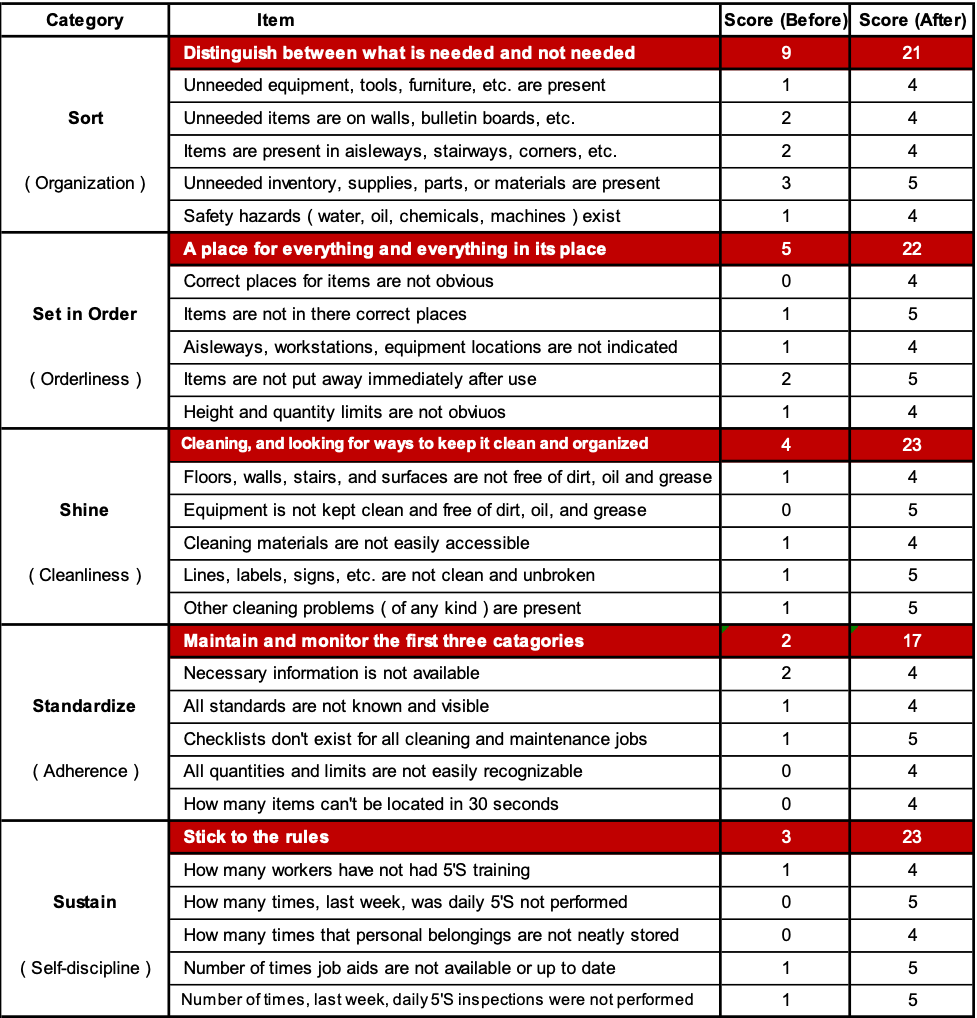
Lean is the willingness to question one’s behaviour at every hierarchical level, learn from mistakes, and develop new solutions for a zero-waste process. Lean means constant customer-focused and value-adding thinking.
When talking about lean management, we need to look at what it means in general and how it differs from lean manufacturing and reduces waste in the production process. In contrast, lean management drives an organization toward continuous improvement. The concept of lean management has principles, methods, and tools that differ from traditional methods. Lean management tools are the set of methods or practical applications of the proposed system. Such tools include the 5S workplace organization system, Just-in-Time, Kanban, Kaizen, quick changeover (SMED), error prevention, value stream mapping, Total Productive Maintenance, Visual Management, etc. During the study, one of the lean management tools, the implementation of 5S, was considered. The 5S system is a set of measures for the rational organization of workplaces, which can
improve job security, productivity, product quality, and production culture. The system got its name from the first letters of five Japanese words: Seri, Seton, Sesu, Seketsu, and Shatsuke. They are translated as “sort,” “arrange,” “standardize,” and “sustain. “The system lays down five steps, the implementation of which aims to save time and energy to carry out operations, maintain order, cleanliness, and accuracy, increase productivity, prevent accidents and reduce environmental pollution. The 5S system helps to quickly remove the accumulated waste product and eliminate its appearance in the future. Using the 5S system allows for creating of an efficient workplace, which increases cost savings, quality improvement, productivity, productivity, and safety.
5S Principles
| Principle | Description |
| 1. Sort: get rid of all unnecessary | All items are divided into the categories: unnecessary, not needed urgently, and necessary. The necessary ones are stored in the workplace. |
| 2. Set in order. Determine the place for each item | Concerning the necessary objects and urgently needed. Solutions are developed and implemented that ensure speed, ease, and safety of access to them, visualization of the storage method and control of the presence, absence, or location of the desired item, freedom of movement of objects, and aesthetics of the production environment. |
| 3. Keep the workplace clean | General cleanliness of the premises. Thorough sweeping and cleaning equipment, fixing and troubleshooting, and identification of sources of pollution and problem areas. Development and implementation of measures to clean hard-to-reach places. Elaborate on rules for cleaning, equipment cleaning, lubrication, and inspection. |
| 4. Standardize cleanliness and orderliness | Fixing in writing the rules, removal of unnecessary, rational placement of objects, cleaning, lubrication, and inspections. Full visualization of rules presentation (drawings, diagrams, icons, pointers, colour coding). Visualization of the control of the normal state and deviations (in the equipment, stock levels, etc.). Standardization and unification of all symbols (size, colour, symbol image, etc.) Rationalization of information carriers (material, method of inscription, protective coatings), their placement, and attachment points. |
| 5. Improve and Control | Fixing the areas of responsibilities for each employee (the objects of attention and the main responsibilities for maintaining them in good condition). Developing the right habits of the staff, consolidating the skills of compliance with the rules. The use of effective methods of control and audits. |
5S workplace System Implementation:
This case study was conducted in an automotive company. The company’s management wanted to eliminate the waste of time on the production floor. The information and data were gathered through observation of the production floor and some records. Finally, data were analyzed, and the root cause was identified. The below table shows the type of waste.

The waste-responsibility matrix shows the type of waste, the reason for the waste produced, and the responsibility for producing that waste. The matrix shows that man is primarily responsible for waste.
Responsibility was divided into four main process parameters, i.e., man, machine, method and others, which include environment, methods etc. Reasons against each waste are placed.
A 5S audit checklist is prepared, and an audit is conducted on the production floor. The audit is based on the scoring criteria between 0 and 25. The score is written against each 5S requirement. An average score of each category is composed. The checklist is prepared, which contains the following content against each 5S category.


The 5S audit was carried out before and after the implementation of 5S. It was observed that before implementation, there was a severe concern about each 5S requirement on the production floor.
The average score against each 5S principle was between 0-5. 5S awareness sessions were conducted. Responsibilities are assigned, and a target is set. The activity of 5S started, and after 30 days, a significant change was seen in the production floor. After implementation, again 5S audit was carried out, and a considerable improvement was seen on the production floor.
The lean management tool, the 5S workplace management system, is applied during the study. Before 5S analysis, various types of waste were identified. During the 5S audit, it was found that a lot of unnecessary elements exist on the production floor, such as excess baskets, trolleys, inventory backlog, etc. sometimes, items were not put away immediately after use. In a few cases, height and quantity limits are not marked. The lighting arrangement is also not suitable for the production floor. Dust existed on the production floor, which was unhealthy for the workers. As a result, labour productivity, as well as productivity in the workplace, is decreased. With the implementation of 5S, a healthy work environment was established, no time was wasted searching for items, and everything was in its designated place, resulting in enhanced production efficiency.
